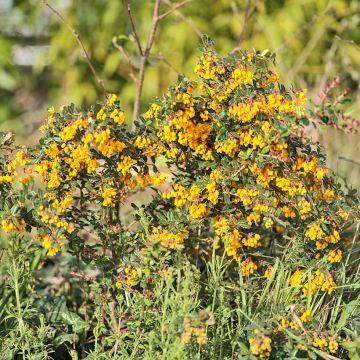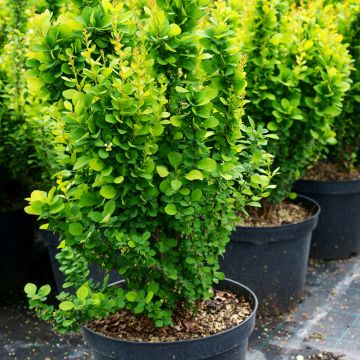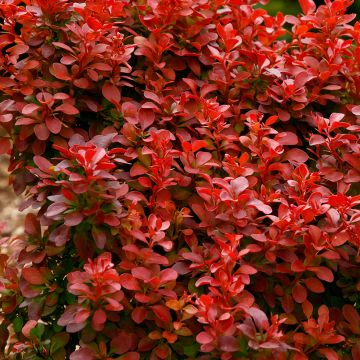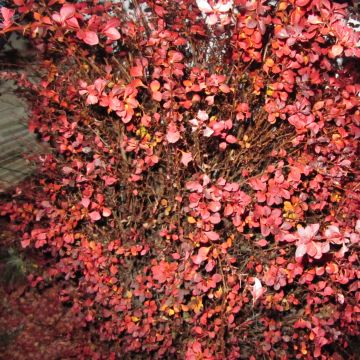

Berberis thunbergii Silver Pillar
Berberis thunbergii Silver Pillar
Berberis thunbergii Silver Pillar
Japanese Barberry, Thunberg's Barberry
Special offer!
Receive a €20 voucher for any order over €90 (excluding delivery costs, credit notes, and plastic-free options)!
1- Add your favorite plants to your cart.
2- Once you have reached €90, confirm your order (you can even choose the delivery date!).
3- As soon as your order is shipped, you will receive an email containing your voucher code, valid for 3 months (90 days).
Your voucher is unique and can only be used once, for any order with a minimum value of €20, excluding delivery costs.
Can be combined with other current offers, non-divisible and non-refundable.
Why not try an alternative variety in stock?
View all →This plant carries a 24 months recovery warranty
More information
We guarantee the quality of our plants for a full growing cycle, and will replace at our expense any plant that fails to recover under normal climatic and planting conditions.
Would this plant suit my garden?
Set up your Plantfit profile →
Description
The Berberis thunbergii 'Silver Pillar' is a variety of barberry with an upright and compact habit, particularly ornamental with its deciduous foliage that changes colours during the growing season. The young leaves emerge in shades of yellow before turning to a green speckled with cream-white. Its discreet yellow spring flowering is followed by the formation of red berries, which coexist with the autumn foliage that turns reddish-orange and persists until winter. Easy to grow, very cold-resistant, and accepting most well-drained soils, this shrub is suitable for low hedges, integrates well into diverse flower beds, and can be planted in containers.
Berberis is one of the 14 genera in the Berberidaceae family, including Nandina, sacred bamboo, Epimedium, graphic flowers, and the rarer Podophyllum, with astonishing leaves. There are 450 to 500 species of Berberis, a highly diversified genus of deciduous or evergreen shrubs with green or coloured foliage and with either undeveloped or formidable, and sometimes even ornamental, thorns. Recognisable by its yellow wood, Berberis gets its name from the Arabic word "berberys," which means its fruit.
The Berberis thunbergii, also known as Thunberg's barberry or Japanese barberry, originates from Japan and was introduced to Europe as early as 1864. The species is characterised by a compact and regular habit, reaching a height of 1.50 m. It is best known for its numerous cultivars with purple, golden, pink, and white leaves, among others. It has also produced hybrids, such as B. x ottawensis, through cross-breeding with Berberis vulgaris, which is also appreciated for its various cultivars.
'Silver Pillar' is an upright form that is beautiful due to its changing foliage. With moderate growth, the shrub reaches a height of 1.50 m and a width of 80 cm within ten years, and at maturity, after 20 years in the ground, it can get a height of 2 m with a spread of 1.20 m. Its columnar silhouette is attractive throughout the year, especially in spring when young shoots emerge towards the sky in shades of yellow. The small obovate to spatulate leaves, approximately 3 cm long, then turn green with cream-white spots. This mature foliage retains these mixed colours during the growing season, ending beautifully in autumn when it turns reddish-orange before the leaves fall. In spring, around May, depending on the climate, the shrub produces small yellow flowers, only 6 to 8 mm in diameter and therefore relatively inconspicuous. Grouped in clusters of 2 to 4, they are appreciated by pollinators such as bees and butterflies. In autumn, they give rise to small elliptical berries, 8 to 12 mm long, bright red and very ornamental, which often persist until winter, providing food for passing birds.
As one of the easiest shrubs to grow, the 'Silver Pillar' Japanese barberry is a very adaptable plant in terms of soil, tolerating pruning well and preferring sunny but not scorching exposures (in the Mediterranean and Southwest, it is best planted under light shade). You can use it in a mixed hedge, where it only requires annual pruning with shears or even left in its natural shape. Plant the Photinia x fraseri 'Magical Volcano' alongside it to create a vivid contrast of foliage colours. This Photinia retains its young bright red leaves for a long time, which stand out against the dark green mature foliage. The Prunus laurocerasus 'Green Torch', an upright and slow-growing cherry laurel, will also be a good companion for a hedge. In a flower bed, you can associate your Berberis with purple foliage plants, such as the Physocarpus opulifolius 'Lady in Red', a small shrub that also offers a pleasant spring flowering with white corymbs that later turn into small red fruits. The Cotinus coggygria 'Dusky Maiden' with its oval purple leaves will also allow you to create a strong contrast with your Berberis.
Plant habit
Flowering
Foliage
Botanical data
Berberis
thunbergii
Silver Pillar
Berberidaceae
Japanese Barberry, Thunberg's Barberry
Cultivar or hybrid
Other Berberis - Barberries
View all →Planting and care
The Berberis thunbergii 'Silver Pillar' is very hardy, up to -25°C approximately. It can be planted in a sunny position in spring or autumn, in any fresh, well-drained soil, even limestone, poor or stony. Reserve partial shade for warmer climates. Water generously and frequently during the first summers, but fertilising is unnecessary. It requires little maintenance; keep the soil moist, especially in summer. For Berberis planted in hedges, balance the shape in spring and September. Trim the branches after flowering in free hedges to give the bush a rounded, balanced form. Be careful not to touch the branches with bare hands, as they have thorns that are difficult to remove once they penetrate the skin.
Planting period
Intended location
Care
Planting & care advice
This item has not been reviewed yet - be the first to leave a review about it.
Similar products
Haven't found what you were looking for?
Hardiness is the lowest winter temperature a plant can endure without suffering serious damage or even dying. However, hardiness is affected by location (a sheltered area, such as a patio), protection (winter cover) and soil type (hardiness is improved by well-drained soil).

Photo Sharing Terms & Conditions
In order to encourage gardeners to interact and share their experiences, Promesse de fleurs offers various media enabling content to be uploaded onto its Site - in particular via the ‘Photo sharing’ module.
The User agrees to refrain from:
- Posting any content that is illegal, prejudicial, insulting, racist, inciteful to hatred, revisionist, contrary to public decency, that infringes on privacy or on the privacy rights of third parties, in particular the publicity rights of persons and goods, intellectual property rights, or the right to privacy.
- Submitting content on behalf of a third party;
- Impersonate the identity of a third party and/or publish any personal information about a third party;
In general, the User undertakes to refrain from any unethical behaviour.
All Content (in particular text, comments, files, images, photos, videos, creative works, etc.), which may be subject to property or intellectual property rights, image or other private rights, shall remain the property of the User, subject to the limited rights granted by the terms of the licence granted by Promesse de fleurs as stated below. Users are at liberty to publish or not to publish such Content on the Site, notably via the ‘Photo Sharing’ facility, and accept that this Content shall be made public and freely accessible, notably on the Internet.
Users further acknowledge, undertake to have ,and guarantee that they hold all necessary rights and permissions to publish such material on the Site, in particular with regard to the legislation in force pertaining to any privacy, property, intellectual property, image, or contractual rights, or rights of any other nature. By publishing such Content on the Site, Users acknowledge accepting full liability as publishers of the Content within the meaning of the law, and grant Promesse de fleurs, free of charge, an inclusive, worldwide licence for the said Content for the entire duration of its publication, including all reproduction, representation, up/downloading, displaying, performing, transmission, and storage rights.
Users also grant permission for their name to be linked to the Content and accept that this link may not always be made available.
By engaging in posting material, Users consent to their Content becoming automatically accessible on the Internet, in particular on other sites and/or blogs and/or web pages of the Promesse de fleurs site, including in particular social pages and the Promesse de fleurs catalogue.
Users may secure the removal of entrusted content free of charge by issuing a simple request via our contact form.
The flowering period indicated on our website applies to countries and regions located in USDA zone 8 (France, the United Kingdom, Ireland, the Netherlands, etc.)
It will vary according to where you live:
- In zones 9 to 10 (Italy, Spain, Greece, etc.), flowering will occur about 2 to 4 weeks earlier.
- In zones 6 to 7 (Germany, Poland, Slovenia, and lower mountainous regions), flowering will be delayed by 2 to 3 weeks.
- In zone 5 (Central Europe, Scandinavia), blooming will be delayed by 3 to 5 weeks.
In temperate climates, pruning of spring-flowering shrubs (forsythia, spireas, etc.) should be done just after flowering.
Pruning of summer-flowering shrubs (Indian Lilac, Perovskia, etc.) can be done in winter or spring.
In cold regions as well as with frost-sensitive plants, avoid pruning too early when severe frosts may still occur.
The planting period indicated on our website applies to countries and regions located in USDA zone 8 (France, United Kingdom, Ireland, Netherlands).
It will vary according to where you live:
- In Mediterranean zones (Marseille, Madrid, Milan, etc.), autumn and winter are the best planting periods.
- In continental zones (Strasbourg, Munich, Vienna, etc.), delay planting by 2 to 3 weeks in spring and bring it forward by 2 to 4 weeks in autumn.
- In mountainous regions (the Alps, Pyrenees, Carpathians, etc.), it is best to plant in late spring (May-June) or late summer (August-September).
The harvesting period indicated on our website applies to countries and regions in USDA zone 8 (France, England, Ireland, the Netherlands).
In colder areas (Scandinavia, Poland, Austria...) fruit and vegetable harvests are likely to be delayed by 3-4 weeks.
In warmer areas (Italy, Spain, Greece, etc.), harvesting will probably take place earlier, depending on weather conditions.
The sowing periods indicated on our website apply to countries and regions within USDA Zone 8 (France, UK, Ireland, Netherlands).
In colder areas (Scandinavia, Poland, Austria...), delay any outdoor sowing by 3-4 weeks, or sow under glass.
In warmer climes (Italy, Spain, Greece, etc.), bring outdoor sowing forward by a few weeks.




































































